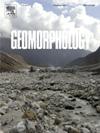How did the Hukou Waterfall of the Yellow River form?
IF 3.1
2区 地球科学
Q2 GEOGRAPHY, PHYSICAL
引用次数: 0
Abstract
Waterfalls are steep steps in river sections that longitudinally break river channels, typically found in drainage systems with tectonically active conditions. However, large waterfalls can also form in tectonically inactive areas, creating a phenomenon that is not yet fully understood. The Hukou Waterfall, located in the Jinshaan Gorge of the Yellow River, an area generally considered tectonically stable, preserves datable landforms and provides an opportunity to study the formation and propagation processes of waterfalls. In this study, we reconstruct the paleochannel associated with the recession of the Hukou Waterfall by correlating fluvial terraces and paleo-outlets. Our results suggest that the waterfall once existed at a paleo base level approximately 65 m higher than its current position. The migration rates of the waterfall varied between 16.9 and 30.3 cm/a during its recession, with faster recession during inter-glacial periods. Based on these findings, we estimate that the Hukou Waterfall entered the Jinshaan Gorge between 233.5 and 260.0 ka, and propose that the Hukou Waterfall originated from a sudden drop in base level due to drainage integration between the Fenwei Basin and the Sanmen Gorge. Our analysis also shows that migration rates, as well as overburden on waterfall-related terraces, correlate with cyclic climate patterns, highlighting the role of climate variability in driving waterfall migration over time. These findings may help refine models of river incision, base-level change, and knickpoint migration, contributing to the broader understanding of waterfall migration patterns in response to both climate and tectonic changes and offering a template for studying landform evolution in other river systems worldwide.
黄河壶口瀑布是如何形成的?
瀑布是河流中纵向断裂河道的陡峭台阶,通常在构造活跃的排水系统中发现。然而,大瀑布也可能在构造不活跃的地区形成,造成一种尚未完全理解的现象。壶口瀑布位于黄河金山峡,是一个通常被认为构造稳定的地区,它保留了古老的地貌,为研究瀑布的形成和传播过程提供了机会。本研究通过对比河流梯田和古出口,重建了壶口瀑布退缩的古河道。我们的研究结果表明,瀑布曾经存在于比现在高约65米的古基准面。大瀑布在退缩期的迁移速率在16.9 ~ 30.3 cm/a之间变化,间冰期的迁移速度更快。据此推测,壶口瀑布在233.5 ~ 260.0 ka之间进入金山峡,形成于汾渭盆地与三门峡的流域整合过程中基准面的突然下降。我们的分析还表明,迁移率以及与瀑布有关的梯田上的覆盖层与循环气候模式相关,突出了气候变化在推动瀑布迁移中的作用。这些发现可能有助于完善河流切口、基准面变化和裂缝点迁移模型,有助于更广泛地了解气候和构造变化对瀑布迁移模式的响应,并为研究全球其他河流系统的地貌演化提供模板。
本文章由计算机程序翻译,如有差异,请以英文原文为准。
求助全文
约1分钟内获得全文
求助全文
来源期刊

Geomorphology
地学-地球科学综合
CiteScore
8.00
自引率
10.30%
发文量
309
审稿时长
3.4 months
期刊介绍:
Our journal''s scope includes geomorphic themes of: tectonics and regional structure; glacial processes and landforms; fluvial sequences, Quaternary environmental change and dating; fluvial processes and landforms; mass movement, slopes and periglacial processes; hillslopes and soil erosion; weathering, karst and soils; aeolian processes and landforms, coastal dunes and arid environments; coastal and marine processes, estuaries and lakes; modelling, theoretical and quantitative geomorphology; DEM, GIS and remote sensing methods and applications; hazards, applied and planetary geomorphology; and volcanics.
 求助内容:
求助内容: 应助结果提醒方式:
应助结果提醒方式:


